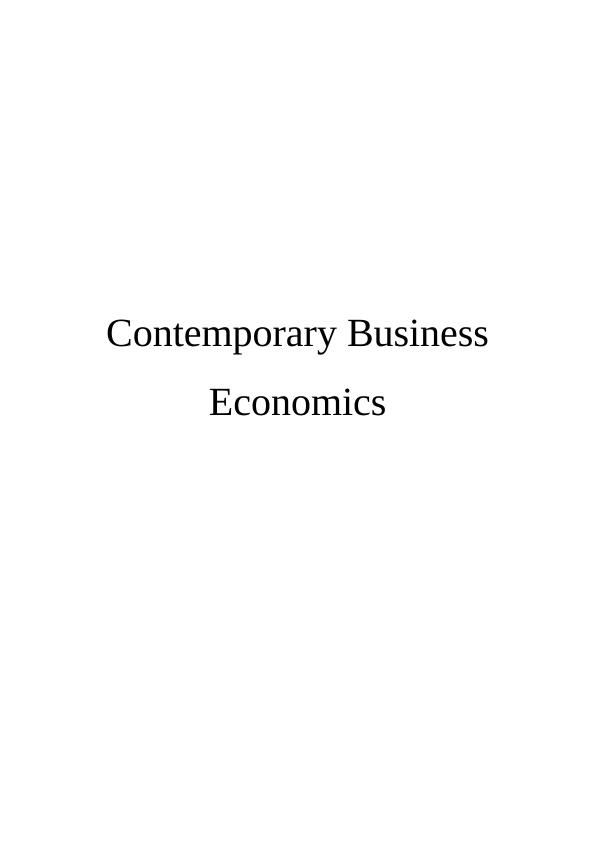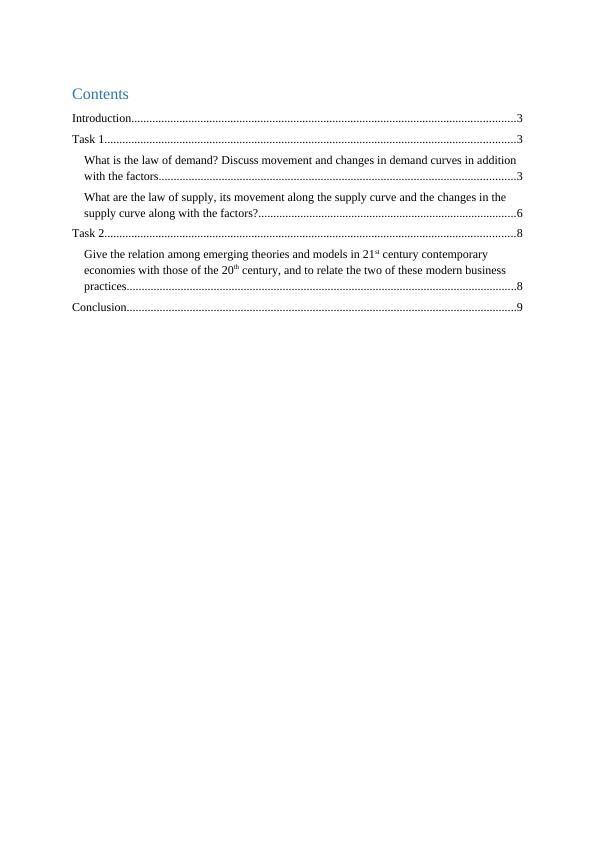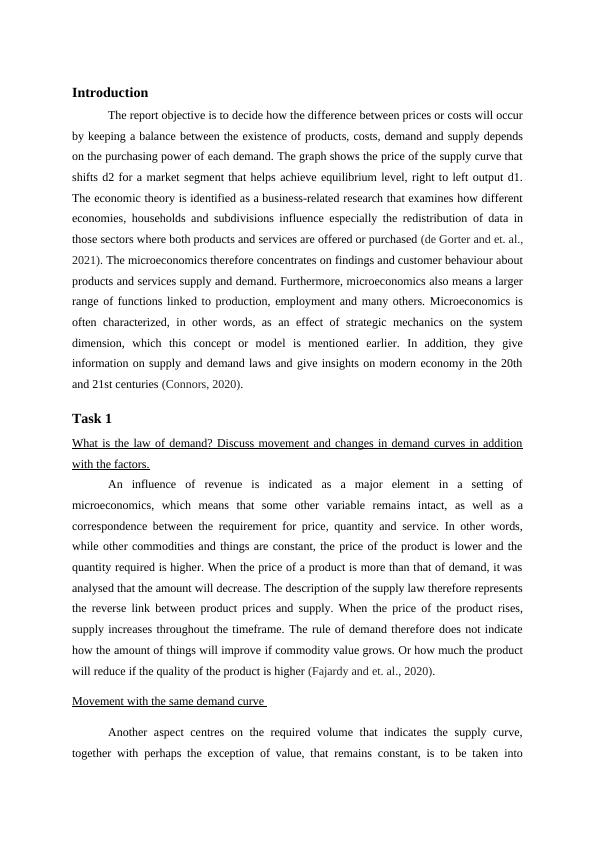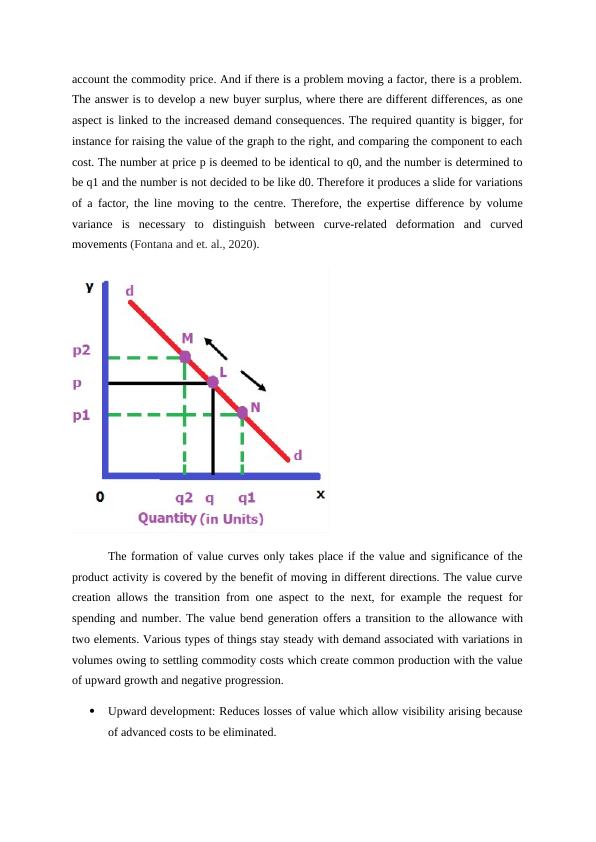Contemporary Business: Law of Demand and Supply
Added on 2022-12-15
12 Pages2800 Words280 Views
Contemporary Business
Economics
Economics

Contents
Introduction................................................................................................................................3
Task 1.........................................................................................................................................3
What is the law of demand? Discuss movement and changes in demand curves in addition
with the factors.......................................................................................................................3
What are the law of supply, its movement along the supply curve and the changes in the
supply curve along with the factors?......................................................................................6
Task 2.........................................................................................................................................8
Give the relation among emerging theories and models in 21st century contemporary
economies with those of the 20th century, and to relate the two of these modern business
practices..................................................................................................................................8
Conclusion..................................................................................................................................9
Introduction................................................................................................................................3
Task 1.........................................................................................................................................3
What is the law of demand? Discuss movement and changes in demand curves in addition
with the factors.......................................................................................................................3
What are the law of supply, its movement along the supply curve and the changes in the
supply curve along with the factors?......................................................................................6
Task 2.........................................................................................................................................8
Give the relation among emerging theories and models in 21st century contemporary
economies with those of the 20th century, and to relate the two of these modern business
practices..................................................................................................................................8
Conclusion..................................................................................................................................9

Introduction
The report objective is to decide how the difference between prices or costs will occur
by keeping a balance between the existence of products, costs, demand and supply depends
on the purchasing power of each demand. The graph shows the price of the supply curve that
shifts d2 for a market segment that helps achieve equilibrium level, right to left output d1.
The economic theory is identified as a business-related research that examines how different
economies, households and subdivisions influence especially the redistribution of data in
those sectors where both products and services are offered or purchased (de Gorter and et. al.,
2021). The microeconomics therefore concentrates on findings and customer behaviour about
products and services supply and demand. Furthermore, microeconomics also means a larger
range of functions linked to production, employment and many others. Microeconomics is
often characterized, in other words, as an effect of strategic mechanics on the system
dimension, which this concept or model is mentioned earlier. In addition, they give
information on supply and demand laws and give insights on modern economy in the 20th
and 21st centuries (Connors, 2020).
Task 1
What is the law of demand? Discuss movement and changes in demand curves in addition
with the factors.
An influence of revenue is indicated as a major element in a setting of
microeconomics, which means that some other variable remains intact, as well as a
correspondence between the requirement for price, quantity and service. In other words,
while other commodities and things are constant, the price of the product is lower and the
quantity required is higher. When the price of a product is more than that of demand, it was
analysed that the amount will decrease. The description of the supply law therefore represents
the reverse link between product prices and supply. When the price of the product rises,
supply increases throughout the timeframe. The rule of demand therefore does not indicate
how the amount of things will improve if commodity value grows. Or how much the product
will reduce if the quality of the product is higher (Fajardy and et. al., 2020).
Movement with the same demand curve
Another aspect centres on the required volume that indicates the supply curve,
together with perhaps the exception of value, that remains constant, is to be taken into
The report objective is to decide how the difference between prices or costs will occur
by keeping a balance between the existence of products, costs, demand and supply depends
on the purchasing power of each demand. The graph shows the price of the supply curve that
shifts d2 for a market segment that helps achieve equilibrium level, right to left output d1.
The economic theory is identified as a business-related research that examines how different
economies, households and subdivisions influence especially the redistribution of data in
those sectors where both products and services are offered or purchased (de Gorter and et. al.,
2021). The microeconomics therefore concentrates on findings and customer behaviour about
products and services supply and demand. Furthermore, microeconomics also means a larger
range of functions linked to production, employment and many others. Microeconomics is
often characterized, in other words, as an effect of strategic mechanics on the system
dimension, which this concept or model is mentioned earlier. In addition, they give
information on supply and demand laws and give insights on modern economy in the 20th
and 21st centuries (Connors, 2020).
Task 1
What is the law of demand? Discuss movement and changes in demand curves in addition
with the factors.
An influence of revenue is indicated as a major element in a setting of
microeconomics, which means that some other variable remains intact, as well as a
correspondence between the requirement for price, quantity and service. In other words,
while other commodities and things are constant, the price of the product is lower and the
quantity required is higher. When the price of a product is more than that of demand, it was
analysed that the amount will decrease. The description of the supply law therefore represents
the reverse link between product prices and supply. When the price of the product rises,
supply increases throughout the timeframe. The rule of demand therefore does not indicate
how the amount of things will improve if commodity value grows. Or how much the product
will reduce if the quality of the product is higher (Fajardy and et. al., 2020).
Movement with the same demand curve
Another aspect centres on the required volume that indicates the supply curve,
together with perhaps the exception of value, that remains constant, is to be taken into

account the commodity price. And if there is a problem moving a factor, there is a problem.
The answer is to develop a new buyer surplus, where there are different differences, as one
aspect is linked to the increased demand consequences. The required quantity is bigger, for
instance for raising the value of the graph to the right, and comparing the component to each
cost. The number at price p is deemed to be identical to q0, and the number is determined to
be q1 and the number is not decided to be like d0. Therefore it produces a slide for variations
of a factor, the line moving to the centre. Therefore, the expertise difference by volume
variance is necessary to distinguish between curve-related deformation and curved
movements (Fontana and et. al., 2020).
The formation of value curves only takes place if the value and significance of the
product activity is covered by the benefit of moving in different directions. The value curve
creation allows the transition from one aspect to the next, for example the request for
spending and number. The value bend generation offers a transition to the allowance with
two elements. Various types of things stay steady with demand associated with variations in
volumes owing to settling commodity costs which create common production with the value
of upward growth and negative progression.
Upward development: Reduces losses of value which allow visibility arising because
of advanced costs to be eliminated.
The answer is to develop a new buyer surplus, where there are different differences, as one
aspect is linked to the increased demand consequences. The required quantity is bigger, for
instance for raising the value of the graph to the right, and comparing the component to each
cost. The number at price p is deemed to be identical to q0, and the number is determined to
be q1 and the number is not decided to be like d0. Therefore it produces a slide for variations
of a factor, the line moving to the centre. Therefore, the expertise difference by volume
variance is necessary to distinguish between curve-related deformation and curved
movements (Fontana and et. al., 2020).
The formation of value curves only takes place if the value and significance of the
product activity is covered by the benefit of moving in different directions. The value curve
creation allows the transition from one aspect to the next, for example the request for
spending and number. The value bend generation offers a transition to the allowance with
two elements. Various types of things stay steady with demand associated with variations in
volumes owing to settling commodity costs which create common production with the value
of upward growth and negative progression.
Upward development: Reduces losses of value which allow visibility arising because
of advanced costs to be eliminated.

End of preview
Want to access all the pages? Upload your documents or become a member.
Related Documents
Contemporary Business Economicslg...
|12
|2964
|38
Contemporary Business Economicslg...
|11
|3319
|76
Economics for Businesslg...
|11
|2736
|85
Contemporary Business Economicslg...
|12
|3007
|42
Explaining the Law of Demand and Supply in Contemporary Economicslg...
|15
|3865
|2
Industrial Marketing Managementlg...
|12
|3289
|16